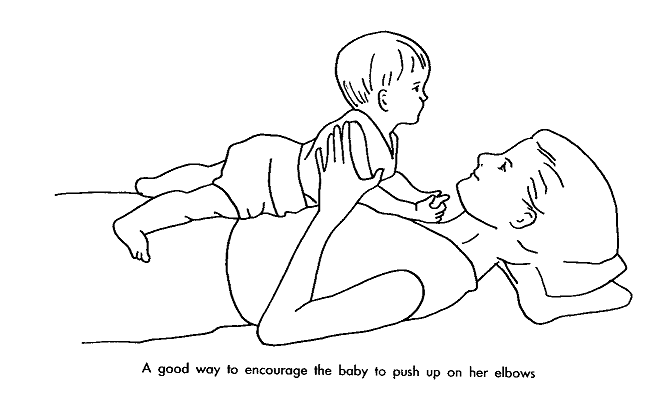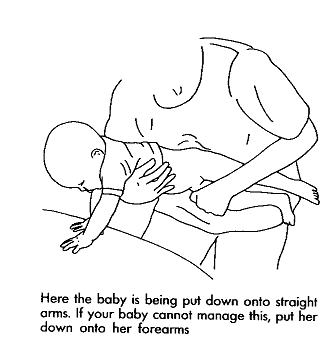GM.A.11 ON TUMMY, BEARS WEIGHT ON FOREARMS, WITH ELBOWS IN FRONT OF SHOULDERS AND CHIN TUCKED
Learning to take body weight on the forearms is very important. The neck and shoulder girdle muscles must all work together to hold this position, and it is these same muscles working as a team that hold the shoulder girdle and neck steady when the child uses her hands for her Fine Motor skills. She will a also need a stable shoulder girdle when she starts to sit, crawl, cruise around furniture and so on.
How to Assess
Method: Place the child on her tummy, her forearms on the floor under her shoulders. Score plus if your child pushes up on her forearms and adjusts her posture so that her elbows are forward or her shoulders. Her head should be held at 90° and her chin tucked in.
How to Teach
Your child should by now have had plenty of practice at bearing her weight with her forearms under her shoulders. If she is having difficulty with this, look back to the item GM.A.5. Now she needs to learn to prop with her arms well forward. If she cannot keep them there herself, place a rolled towel under her arms. Use toys to keep her interested, or place her so that she can watch the general family activity. As soon as she is accustomed to playing in this position, it is important to remove the towel.
Positioning, Carrying and Playing
As well as putting your baby on the floor to play, in the position described above, you can place her over your thigh as you sit on the floor, or place her on your chest, ensuring that her arms are well forward. Encourage her to push up on her elbows by singing, talking, blowing on her hair and so on. Babies enjoy rubbing their feet together exploring one foot with the other. If your child does not do this, take her feet, while she lies on her tummy, and rub them together for her. This is important as a preparation for standing and it helps the baby learn about her own body.
Continue to carry your baby as described in the item GM.A.8. Make sure that your baby’s arms are well forward and not caught back behind her. You could now introduce a new ‘put down’ position. Once again, turn your baby onto her side, but this time, supported around her chest and hips, leaving her arms free. As you approach the surface, twist her forward very slightly, so her arms have a chance to come in contact with the surface first. If she will, let her take some weight through her arms, then continue to place her down onto her side. This method of’ putting her down is in preparation for all her floor play and crawling. Alternate this method with the ‘put down’ in the item GM.A.5.
When you pick your baby up, again roll her to the side, then prop up on her forearm, so she is in a half-lying position. Support her bottom and shoulder if she needs it. Leave her in this position for a few seconds, then continue to pick her up. Take her straight up into the crook of your arm, as described in the item GM.A.8. This side lying position, supported on her forearm, is a wonderful position to place your baby in during the day. While you have her on your lap, support her in this position. You could sit on the floor, with her leaning against your thigh, again in this hall~lying position, If she is tired, she can lean against you, rather than on her forearm. If you can train yourself to always have her ‘off centre’ now, you will find she will very easily pass from skill to the next. Remember to alternate sides.


